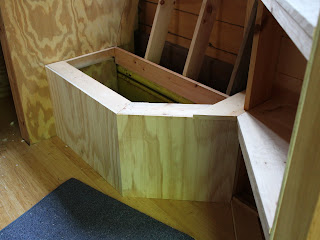And the light that shines through the shining night
Is a lamp that I carried from my mother's home
And the light that burns through the window pane and the love remain
-Stevie Nicks - Blue Lamp
After a long time of not much happening, suddenly, A Great Deal Has Happened.
Episode 1: We go to an Event in Clinton, Break Camp Early, Load, Drive Home, Unload, Load Again, and Drive to Tuxedo
So it turned out that the best plan was to drop the vardo off with Mr. Lars at his Boothe at Sterling Forest Renaissance Festival in Tuxedo and leave it with him a while so he could work at it on his home turf, as it were. Moreover, it worked out in Just Such a Way that the best time to do it was on the Monday of Memorial Day Weekend.
The plan was to attend Settmour Swamp's Quest for Wit and Wisdom event, which we go to every year. (This year's theme was the Quest for the Treasures of Timbuktu.) We would arrive onsite Friday night, and enjoy the event on Saturday and Sunday. Monday morning, we'd break camp, pack up ourselves and Ian's stuff, go home from the site in Clinton, unload EVERYTHING, and strip the vardo down bare, load up ALL THE BUILDING materials and then journey to Tuxedo.
Which is what we did.
Here's some pics of the event:
 |
| Here's the vardo parked, along with Ian's Viking A-frame. Later in the event I set up the awning, but I didn't take a picture of it. |
 |
| Jazz Paws! |
Here's an interesting aside: When we got home, we found all our lawn-gargoyles having a kaffeeklatsch on our doorstep. (We do not know how they got this way. Apparently they can only move when you're not looking.)
 |
| One lump or two, Gertrude? |
After pondering the gargoyle mystery a moment or two, we hopped back in the truck and dropped Brigitte off at Daddy Lars' Armoury Shoppe. Here she is parked with one of her four sisters, ready for action:
I must say, I rather prefer the Ren Faire when it's all empty and peaceful. It was quite lovely.
 |
| The bed deck area. He's put up insulation and wainscot paneling, and created shelves at the head and foot. |
 |
| A bench. Wainscoting applied, but the lid and bench back still need to be put on. |
 |
| Corner shelving and closet area. The closet will have a curtain for the door. |
(Or, Jenny learns to solder.)
While the vardo's gone, we decided to do some of the projects that don't require the vardo being present to accomplish. Firstly, the lighting.
Last year, I ordered several star-shaped lanterns from various places online. We got two rose-colored seven-pointed lanterns and four white five-pointed lanterns. The rose-colored ones are destined to be 'porch lights', and the whites are for the interior.
We're planning on installing a 12v electrical system powered by a battery located in one of the bench seats. I got a whole bunch of 12v marine grade outlets and plugs. Lars will be wiring the vardo. Meantime, Norm and I wired the lanterns to use 12v LED lights. The plan is to have an outlet near the ceiling with a switch for each, so the lanterns can be unplugged and stowed for travel.
Step 1: Wire the Plugs:
I used a lamp cord replacement and cut the 8' length into four 2' lengths. Then I simply followed the directions that were provided by the plug manufacturer. The hardest part was getting all those hair-thin wires twisted together tightly enough so that they'd go into the terminal holes.
Step 2: Drill a Hole
The two 7-pointed lamps had a shallow brass dish which was designed to hold a votive candle. I had Norm drill a small hole for the wire here. (Norm did this part because I didn't want to risk breaking the fragile glass with my half-assed inexperienced attempt.)
Step 3: Thread the Wire Through and Solder it to the Socket Tails
I threaded the wire through the hole and then soldered it to the LED light socket. Here is my very first attempt at soldering; how did I do? (Norm said they were 'tits-and-beer' so I guess that means a good first effort!)
We used 'liquid tape' to seal the wires back up:
Step 4: Cable Ties
Next I used cable ties to secure the wires to the frame of the lantern. Since they're going to hang up, I exited the plug end through the top. All the ties were clipped off short.
Step 5: Light 'er Up!
We plugged each light into the 12v outlet in my car to test. Ta-DA! Pretty, Yes?
Each LED bulb gives the equivalent of a 30-watt incandescent. Here's a link to the place I got them: LED Light Bulb
They're only about $4 each. This is a really great website, too - lots of different LED types for different purposes. We chose these because they got lots of good reviews for different applications, and they were (hopefully) bright enough without being so bright they blind our campmates. (That would be bad.)
Next: Brigitte is Back Home and ERMAGHERD THERE ARE SO MANY PROJECTS TO DO I'LL NEVER HAVE ENOUGH TIME FOR THEM ALLLLLLLLLLLLLLLL!!!!!!!















